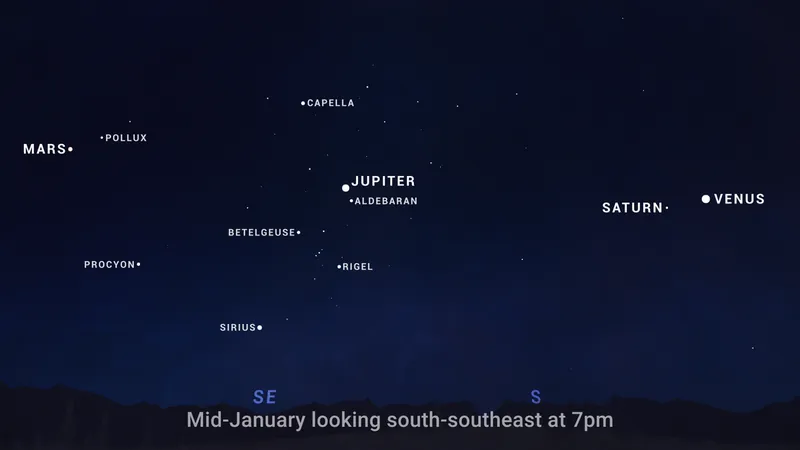
Stargazers Rejoice: Witness the Incredible 'Planet Parade' of January!
2025-01-11
Author: Rajesh
Introduction
This January, the night sky is set to dazzle enthusiasts and casual observers alike with a breathtaking celestial event—what NASA delightfully refers to as a 'planet parade.' Prepare to be amazed as Venus, Mars, Jupiter, and Saturn align beautifully, making it a prime opportunity for stargazers to witness this rare occurrence.
Mars at Its Closest
Kicking off with the planets' notable performances, January gives us a special treat as Mars reaches its closest proximity to Earth this weekend, shining brilliantly alongside its fellow planetary siblings. Preston Dyches of NASA's Jet Propulsion Laboratory has enthused about this spectacle, stating, 'In January, you'll have the opportunity to take in four bright planets in a sweeping view. These multi-planet viewing opportunities aren’t super rare, but they don’t happen every year, so it’s worth checking out.'
Viewing the Planets
Throughout the month, Saturn and Venus will dominate the southwestern sky just after sunset, captivating viewers for the first few hours of the night. Jupiter will shine majestically overhead all night, while Mars will rise in the eastern sky, exhibiting its distinctive ruddy red hue—perfectly visible with the help of telescopes or binoculars. And if you’re thinking about what gear to use for this celestial viewing, check our detailed guides on the best telescopes and binoculars available!
Understanding the Alignment
As these four planets appear to line up, don't be fooled—this planetary alignment is an expected phenomenon. As Dyches elaborates, 'While it's true they will appear more or less along a line across the sky, that's what planets always do.' This line, known as the ecliptic, is part of the solar system’s plane, where planets orbit the sun.
Planetary Conjunction
Mark your calendars for January 17 and 18, when Venus and Saturn will come exceptionally close in a spectacular event known as a planetary conjunction. This celestial meetup is certainly one of the highlights for enthusiasts looking to experience the grandeur of the night sky.
Beyond the Bright Four
But don’t limit your gaze to only these four shining beacons! Dyches pointed out that Uranus and Neptune are also busy in the heavens. Although they aren’t as bright as the aforementioned planets, they technically still exist within the night sky. Observers wanting to hunt for these distant gas giants will need to employ a telescope for a glimpse.
Conclusion
Whether you're an avid astronomer or just curious about the cosmos, this January planet parade presents a stellar chance to connect with the wonders of our solar system. Don’t miss this unforgettable sight — grab your binoculars and enjoy the show!
 Brasil (PT)
Brasil (PT)
 Canada (EN)
Canada (EN)
 Chile (ES)
Chile (ES)
 Česko (CS)
Česko (CS)
 대한민국 (KO)
대한민국 (KO)
 España (ES)
España (ES)
 France (FR)
France (FR)
 Hong Kong (EN)
Hong Kong (EN)
 Italia (IT)
Italia (IT)
 日本 (JA)
日本 (JA)
 Magyarország (HU)
Magyarország (HU)
 Norge (NO)
Norge (NO)
 Polska (PL)
Polska (PL)
 Schweiz (DE)
Schweiz (DE)
 Singapore (EN)
Singapore (EN)
 Sverige (SV)
Sverige (SV)
 Suomi (FI)
Suomi (FI)
 Türkiye (TR)
Türkiye (TR)
 الإمارات العربية المتحدة (AR)
الإمارات العربية المتحدة (AR)